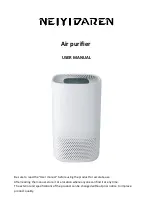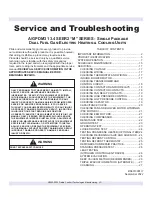
YE
S
Make
n
ece
ss
ary correctio
ns
.
Check the alarm
co
n
te
n
t
s
.
Check the alarm co
n
te
n
t
s
.
T
u
r
n
OFF the i
n
door a
n
d
o
u
tdoor
un
it power.
NO
YE
S
NO
*1
*2
*
3
*
3
*2
CA
S
E 1
CA
S
E 2
CA
S
E
3
B
CA
S
E
3
A
YE
S
YE
S
NO
YE
S
NO
NO
NO
YE
S
YE
S
NO
Recheck the item
s
to check before the te
s
t r
un
.
Have the o
u
tdoor
su
b
un
it
s
bee
n
co
nn
ected?
Are the i
n
ter-
un
it co
n
trol wire
s
co
nn
ected to more tha
n
1 refri
g
era
n
t
s
y
s
tem?
I
s
it po
ss
ible to t
u
r
n
ON the power o
n
ly
for the 1 refri
g
era
n
t
s
y
s
tem where the
te
s
t r
un
will be performed?
Will a
u
tomatic addre
ss
s
etti
ng
be
performed i
n
Heati
ng
mode?
I
s
it OK to
s
tart the compre
ss
or
s
?
T
u
r
n
ON the i
n
door a
n
d
o
u
tdoor
un
it power.
S
hort-circ
u
it the mode cha
ng
e pi
n
(CN101) o
n
the o
u
tdoor mai
n
un
it PCB.
At the
s
ame time,
s
hort-circ
u
it the
a
u
tomatic addre
ss
pi
n
(CN100) for 1
s
eco
n
d or lo
ng
er, the
n
relea
s
e it.
S
hort-circ
u
it the a
u
tomatic addre
ss
pi
n
(CN100) o
n
the o
u
tdoor mai
n
un
it PCB for 1
s
eco
n
d or lo
ng
er,
the
n
relea
s
e it.
S
hort-circ
u
it the a
u
tomatic addre
ss
pi
n
(CN100)
o
n
the o
u
tdoor mai
n
un
it PCB for 1
s
eco
n
d or
lo
ng
er, the
n
relea
s
e it.
S
tart i
n
door a
n
d o
u
tdoor
un
it
cooli
ng
operatio
n
.
LED 1 a
n
d 2 bli
n
k alter
n
ately.
S
tart i
n
door a
n
d o
u
tdoor
un
it
heati
ng
operatio
n
.
LED 1 a
n
d 2 bli
n
k alter
n
ately.
LED 1 a
n
d 2 bli
n
k alter
n
ately
(abo
u
t 2 or
3
mi
nu
te
s
).
I
s
it OK to
s
tart the compre
ss
or
s
?
T
u
r
n
ON the i
n
door a
n
d
o
u
tdoor
un
it power.
T
u
r
n
OFF the i
n
door a
n
d
o
u
tdoor
un
it power.
T
u
r
n
ON the i
n
door a
n
d
o
u
tdoor
un
it power for that
refri
g
era
n
t
s
y
s
tem o
n
ly.
Are LED
s
1 a
n
d 2 o
n
the
o
u
tdoor
un
it PCB OFF?
Are LED
s
1 a
n
d 2 o
n
the
o
u
tdoor
un
it PCB OFF?
S
et the
un
it addre
ss
.
S
et the No. of o
u
tdoor
un
it
s
.
S
et the No. of i
n
door
un
it
s
.
S
et the
s
y
s
tem addre
ss
.
Whe
n
m
u
ltiple o
u
tdoor mai
n
un
it
s
exi
s
t, di
s
co
nn
ect the termi
n
al
s
exte
n
ded from the
s
horted pl
ugs
(CN00
3
) at all o
u
tdoor mai
n
un
it
PCB
s
except for 1.
Alter
n
atively, move the
s
ocket
s
to the OPEN
s
ide.
<O
u
tdoor
un
it co
n
trol PCB>
U
n
it No.
s
etti
ng
s
witch
(
S
007)
<O
u
tdoor
un
it co
n
trol PCB>
U
n
it No.
s
etti
ng
s
witch
(
S
006)
<O
u
tdoor
un
it co
n
trol PCB>
U
n
it No.
s
etti
ng
s
witch
(
S
004 a
n
d
S
005)
<O
u
tdoor
un
it co
n
trol PCB>
U
n
it No.
s
etti
ng
s
witch
(
S
002 a
n
d
S
00
3
)
(Check the li
n
k wiri
ng
.)
*1
The
un
it with the
un
it
No.
s
et to 1 i
s
the
mai
n
un
it. All other
un
it
s
are
su
b
un
it
s
.
Note: It i
s
n
ot
n
ece
ss
ary to remove the
s
ocket
that i
s
us
ed to
s
hort-circ
u
it the termi
n
al
pl
ugs
from the o
u
tdoor
su
b
un
it PCB
s
.
Refer to “Table of
S
elf-Dia
gn
o
s
tic F
un
ctio
ns
a
n
d
De
s
criptio
n
of Alarm Di
s
play
s
.”
*2 A mi
n
im
u
m of 5 ho
u
r
s
m
us
t have pa
ss
ed after the
power wa
s
t
u
r
n
ed ON to the o
u
tdoor
un
it.
*
3
All i
n
door
un
it
s
operate i
n
all refri
g
era
n
t
s
y
s
tem
s
where the power i
s
ON.
Check that te
s
t r
un
preparatio
n
i
s
OK.
(Do
n
ot allow the
s
hort-circ
u
ited pi
ns
to remai
n
s
hort-circ
u
ited.)
Refer to the remote
co
n
troller te
s
t-r
un
s
etti
ngs
.
S
et the wired remote co
n
troller for te
s
t r
un
.
Doe
s
s
y
s
tem operate?
Ret
u
r
n
remote co
n
trol to
n
ormal mode
Check a
n
d make correctio
ns
accordi
ng
to
“Table of
S
elf-Dia
gn
o
s
tic F
un
ctio
ns
.”
E
n
d te
s
t r
un
.
Make
n
ece
ss
ary
correctio
ns
Refer to Fi
g
.
8
-4
Items to Check Before the Test Run
1. Turn the remote power switch on at least 5 hours
before the test, in order to energize the crank
case heater.
2. After performing the leak inspection, applying
vacuum, and performing refrigerant charge for
the tubing which is connected on-site, fully open
the outdoor unit service valve. However if only
one outdoor unit is installed, a balance tube is
not used. Therefore, leave the valve fully closed.
3. When replacing the control PCB, be sure that
the settings on the new PCB match those on the
old PCB.
4. Use caution when making the settings. If there
are duplicated system addresses, or if the
settings for the Nos. of the indoor units are not
consistent, an alarm will occur and the system
will not start.
5. These settings are not made on the indoor unit
PCB.
8-2. Test Run Procedure
Fig. 8-3
71
07-007 W-2WAY_II_NA 1/23/07 6:09 PM Page 71
















































